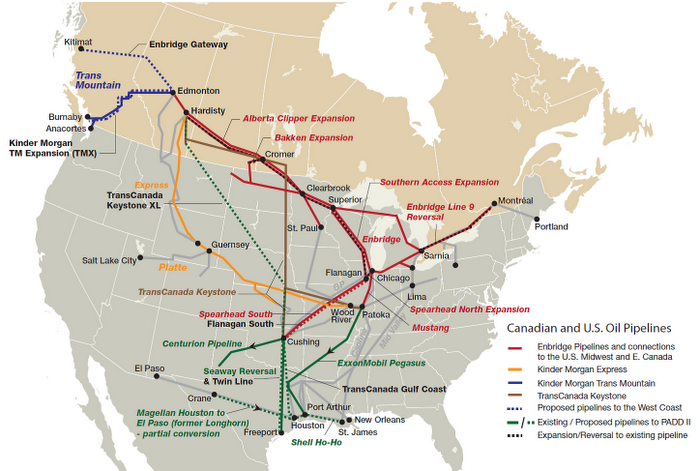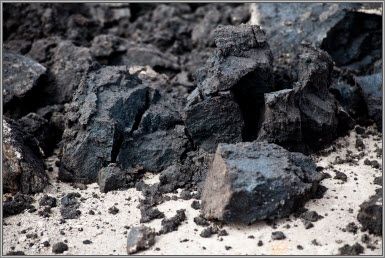What Are the Increased Risks From Transporting Tar Sands Oil?
This is a guest post by University of Washington graduate students Robin, Terry, Shanese, Jeff, Ali, and Colin.
DEC. 13, 2012 — What are tar sands? How are they different than other forms of oil, and why have they been such a hot topic in the news recently? What environmental risks might tar sands oil pose if spilled during transportation? How would this affect NOAA's Office of Response and Restoration (OR&R)?
As tar sands production continues to rise in North America, these are some of the core questions NOAA hopes to answer—and therefore, are the focus of our research.
Our project team of six graduate students at the University of Washington is working to gather information that will help inform OR&R's preparedness and response efforts for potential spills of tar sands oil.

Tar Sands: The Basics
Tar sands, also referred to as oil sands, are a combination of clay, sand, water, and heavy black viscous oil called bitumen. They can be extracted and processed to separate the bitumen, which is upgraded to synthetic crude oil and refined to make asphalt, gasoline, and jet fuel.
Because of its thick consistency (which resembles peanut butter), bitumen, unlike most conventional crude oils, must be diluted with a cocktail of other petroleum compounds before it is able to flow through pumps and tanks or pipelines for transport. This thinner, more fluid product is called diluted bitumen or dilbit.
Another similar blend made from bitumen and synthetic crude oil is called synthetic bitumen or synbit. Over the past decade, this resource which was previously uneconomical due to the high cost of extraction has become profitable as oil prices have increased and extraction technologies have improved. While many countries, including the U.S., have known deposits of tar sands, the world's largest reserves are located across three deposits in northern Alberta, Canada—the Athabasca, Cold Lake, and Peace River deposits. The Government of Alberta estimates its total reserves of bitumen at about 170 billion barrels.

Increased Spill Risks and NOAA
Canada has been producing tar sands products since 1967, but recently, production has ramped up substantially.
Because Canada exports most of its tar sands products, the transportation infrastructure for bitumen—pipelines, rail, and ships—has been expanding as well. A notable example is the proposed TransCanada Keystone XL pipeline which would cross the Canadian-U.S. boundary, extending from Alberta to Texas.
Other proposed projects would increase transportation capacity for tar sands products on both the Atlantic and Pacific Coasts. Expanding traffic to markets in the U.S., Asia, and elsewhere is predicted to increase the potential for spills in and around the Great Lakes, Washington's Puget Sound, and at other major U.S. shipping terminals and river crossings.
NOAA's Office of Response and Restoration has the responsibility to respond to and provide scientific support for oil and chemical spills in U.S. coastal waters. This means OR&R must be able to anticipate and plan for the increased risks that a tar sands oil spill might bring. At present, knowledge about the chemical properties and behavior of tar sands products during a marine spill is limited. For example, would the diluted bitumen float or sink in the brackish waters of many ports, where rivers' fresh water mixes with salty seawater? How should responders be ready to remove that oil if it were suspended in the water column instead of floating on the surface?
These gaps in information make effective spill planning and response more difficult for NOAA and its partners. Key information about tar sands' chemical and physical properties is proprietary, and regulatory agencies' knowledge of where and when this material is being transported is limited as well.
OR&R has been learning on the job how to deal with some of these challenges, as in the 2010 case of an Enbridge pipeline spilling what later turned out to be tar sands oil into Michigan's Kalamazoo River.
Project Scope
Over the past three months we have begun investigating key environmental, economic, and transportation issues facing tar sands oil production. We have met with key players, including NOAA scientists and responders, U.S. Coast Guard, Washington Department of Ecology, oil industry representatives, and environmental groups, to define our research questions and the project scope.
Currently at the halfway point of our project, we are meeting with NOAA to discuss preliminary findings and further refine our research goals for OR&R’s benefit. Here's a peek at what we've found so far:
- To be transported, bitumen is diluted with a variety of petroleum compounds, and some of this information may be considered trade secrets and is not generally shared, with potential implications for human health and environmental impacts.
- Because the base bitumen product has a similar density to water, it has the potential to sink when spilled and undergo significant changes once in the environment—an important consideration for spill response and cleanup.
- Canadian tar sands are currently transported across Canada and the United States by ship, rail, and pipeline, with plans to expand substantially.
- Because the tar sands industry is relatively new and key information is proprietary, there are gaps in knowledge that warrant additional information sharing and research to improve NOAA's and other government agencies' readiness to deal with tar sands oil spills.
The project will wrap up in March 2013, and we will present our final report to the Office and Response and Restoration. We will update our progress on this blog as we get closer to finishing the final report. We look forward to hearing your feedback.
Learn more at our project website: NOAA Oil Sands Project.
Robin, Terry, Shanese, Jeff, Ali, and Colin are graduate students at the University of Washington in programs at the Evans School of Public Affairs, the Foster School of Business, and the School of Environmental and Forest Sciences. OR&R is sponsoring their research project, "Understanding the Risks from Transportation of Tar Sands and Diluted Bitumen" as part of the Environmental Management Certificate Program at the University of Washington. It focuses on providing information to OR&R that will help inform preparedness and response to future spills.
The views expressed here reflect those of the authors and do not necessarily reflect the official views of the National Ocean Service or the federal government.
 An official website of the United States government.
An official website of the United States government. 
